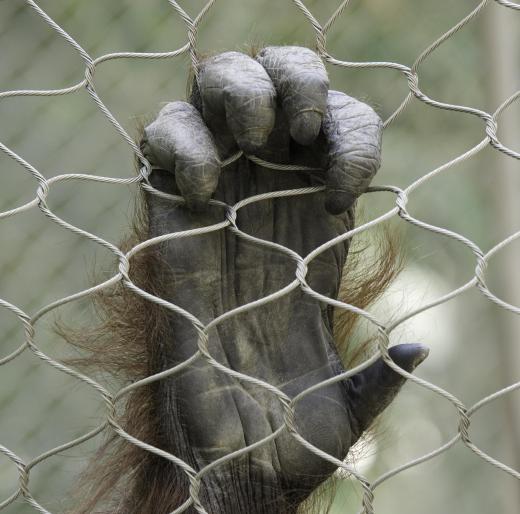What are Primates?
 Michael Anissimov
Michael Anissimov
Primates are an order of placental mammals that includes between 190 and 400 species, depending on whether certain groups are considered subspecies or true distinct species of their own. The number of species is sometimes exaggerated for environmental protection purposes, as approximately 10% of the world's primates are at risk of extinction. Species include lemurs, monkeys, the rare aye-aye, lorises, pottos, galagos, angwantibos, tarsiers, titis, sakis, uakaris, marmosets, tamarins, capuchins, macaques, baboons, mangabeys, chimpanzees, gorillas, orangutans, mandrills, drills, and many others, including humans.
Some of the characteristics of this order are five fingers on each hand and toes on each foot, large brain-to-body ratios, great diversity in size, and manual dexterity. They have improved vision with the simultaneous sacrifice of the size of noses and olfactory centers in the brain, and arboreal lifestyles, including hands and an upper body specialized for grasping tree branches. Their social behavior includes complex dominance hierarchies, and they have long gestation periods and lifespans. It is well known that certain primates, especially apes (which include humans), are among the smartest of all mammals, and indeed all earthly life.

Informally, this order is categorized into three main groups: prosimians, which live on Madagascar and in Southeast Asia; monkeys of the New World; and monkeys and apes of the Old World. Of these, prosimians, such as lemurs, are the most primitive, with small size and long snouts. More formally, the order is divided into two monophyletic (descending from a common ancestor) suborders: Strepsirrhini ("wet-nosed") primates, which includes all non-tarsier prosimians, and Haplorrhini ("dry-nosed") primates, which includes tarsiers, monkeys, and apes.

Primates have existed as far back as 63 million years ago, just 2.5 million years after the mass extinction that killed off the non-avian dinosaurs. The order originated with early strepsirhine animals that are the ancestors of modern lemurs. Tarsiers represented the earliest of the dry-nosed group, splitting off from the wet-nosed animals about 58 million years ago, while primitive monkeys and their cousins split off about 40 million years ago. Homonids (the family including humans, chimpanzees, gorillas, and orangutans) emerged only about 7 million years ago, with humans evolving just 0.2 million years ago.
AS FEATURED ON:
AS FEATURED ON:

















Discuss this Article
Post your comments